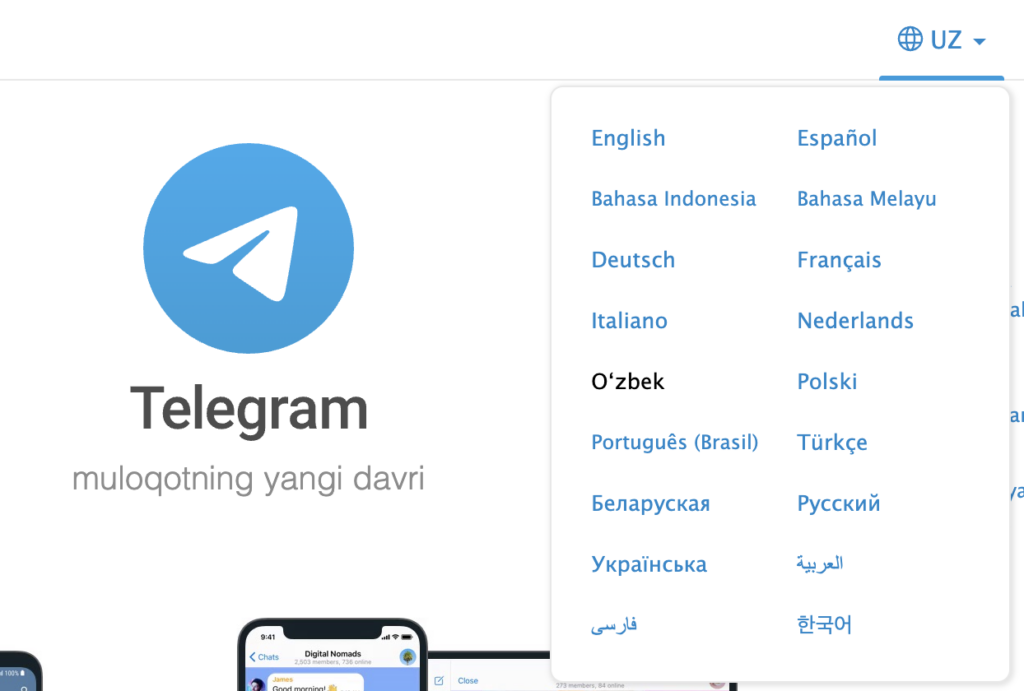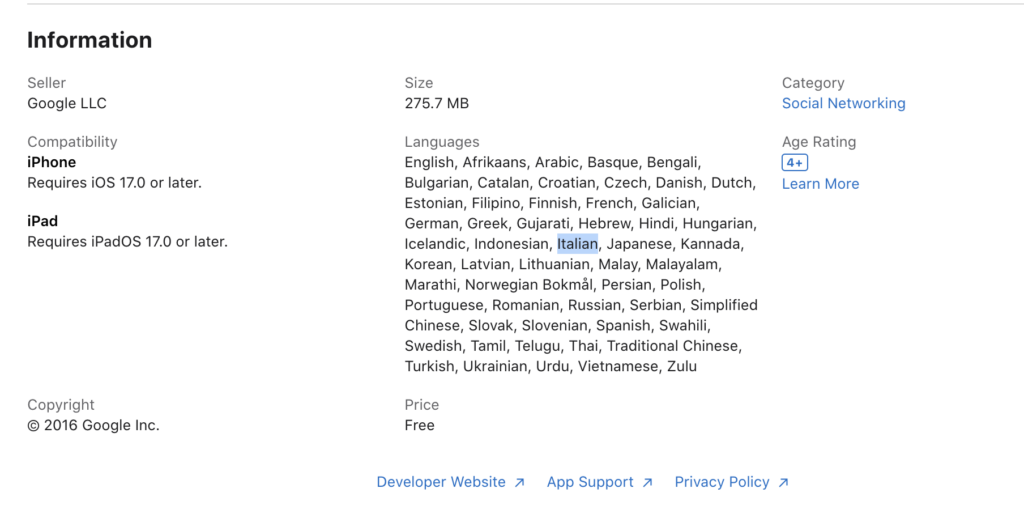Companies often obsess over which category they choose and how they ranking. Choosing an app category can be important to your overall ASO strategy and global growth opportunties.
If you are a strategy lead at a social networking app and you are seeking “top-chart” status, localization of your app & ASO localization should both be baked into your go-to-market strategy and requirements. Below is a look at some of the major players in the social-networking category and how they approach language support (as much as public data allows). Then I put together key lessons and a localization blueprint for your app or product.

Let’s start by looking at the top 12 apps in the Social Networking category of the App Store (as of October 2025).
| App | Languages Supported | Total |
| Threads | English, Croatian, Czech, Danish, Dutch, Finnish, French, German, Greek, Hindi, Hungarian, Indonesian, Italian, Japanese, Korean, Malay, Norwegian Bokmål, Polish, Portuguese, Romanian, Russian, Simplified Chinese, Slovak, Spanish, Swedish, Tagalog, Thai, Traditional Chinese, Turkish, Ukrainian, Vietnamese | 31 |
| English, Arabic, Bengali, Catalan, Croatian, Czech, Danish, Dutch, Finnish, French, German, Greek, Gujarati, Hebrew, Hindi, Hungarian, Indonesian, Irish, Italian, Japanese, Korean, Malay, Marathi, Norwegian Bokmål, Persian, Polish, Portuguese, Romanian, Russian, Simplified Chinese, Slovak, Spanish, Swedish, Thai, Traditional Chinese, Turkish, Ukrainian, Urdu, Vietnamese | 39 | |
| Telegram | English, Arabic, Belarusian, Catalan, Dutch, French, German, Indonesian, Italian, Korean, Malay, Persian, Polish, Portuguese, Russian, Spanish, Turkish, Ukrainian, Uzbek | 19 |
| English, Arabic, Croatian, Czech, Danish, Dutch, Finnish, French, German, Greek, Hebrew, Hindi, Hungarian, Indonesian, Italian, Japanese, Korean, Malay, Norwegian Bokmål, Polish, Portuguese, Romanian, Russian, Simplified Chinese, Slovak, Spanish, Swedish, Thai, Traditional Chinese, Turkish, Ukrainian, Vietnamese | 32 | |
| Discord | *list unavailable currently | 31 |
| Messenger | English, Croatian, Czech, Danish, Dutch, Finnish, French, German, Greek, Hungarian, Indonesian, Italian, Japanese, Korean, Malay, Norwegian Bokmål, Polish, Portuguese, Romanian, Russian, Simplified Chinese, Slovak, Spanish, Swedish, Thai, Traditional Chinese, Turkish, Ukrainian, Vietnamese | 29 |
| Life360 | English, Danish, Dutch, Finnish, French, German, Indonesian, Italian, Japanese, Korean, Norwegian Bokmål, Portuguese, Russian, Simplified Chinese, Spanish, Swedish, Thai, Traditional Chinese, Turkish, Ukrainian, Vietnamese | 21 |
| GoogleMeet | English, Afrikaans, Arabic, Basque, Bengali, Bulgarian, Catalan, Croatian, Czech, Danish, Dutch, Estonian, Filipino, Finnish, French, Galician, German, Greek, Gujarati, Hebrew, Hindi, Hungarian, Icelandic, Indonesian, Italian, Japanese, Kannada, Korean, Latvian, Lithuanian, Malay, Malayalam, Marathi, Norwegian Bokmål, Persian, Polish, Portuguese, Romanian, Russian, Serbian, Simplified Chinese, Slovak, Slovenian, Spanish, Swahili, Swedish, Tamil, Telugu, Thai, Traditional Chinese, Turkish, Ukrainian, Urdu, Vietnamese, Zulu | 55 |
| GroupMe | English, Dutch, French, German, Indonesian, Italian, Japanese, Korean, Polish, Portuguese, Russian, Simplified Chinese, Spanish, Traditional Chinese | 14 |
| TextNow | English, French, Spanish | 3 |
| Signal | English, Arabic, Belarusian, Bengali, Catalan, Croatian, Czech, Danish, Dutch, Finnish, French, German, Greek, Gujarati, Hebrew, Hindi, Hungarian, Indonesian, Irish, Italian, Japanese, Korean, Malay, Marathi, Norwegian Bokmål, Persian, Polish, Portuguese, Romanian, Russian, Serbian, Simplified Chinese, Slovak, Spanish, Swedish, Thai, Traditional Chinese, Turkish, Uighur, Ukrainian, Urdu, Vietnamese | 42 |
| Band | English, Indonesian, Japanese, Korean, Russian, Simplified Chinese, Spanish, Thai, Traditional Chinese | 9 |
What trends do we notice?
The mean or average number of languages that a top 12 app supports is 27.
The median is 30, while the mode 31.
Lower quartile average is 16.5, while the upper quartile is 35.
Why is this significant?
Just in terms of overall competitiveness, without other information the data tells us that language matters. Minimally to achieve success in the Social Networking category, an app should expect to localize their product into at least 27 languages, if not more.
Is their evidence that having a language helps to win over customers?
In my belief, yes. Let’s take a look at an obscure example that may help to explain.
If you quickly scan over the supported languages listed above, you’ll notice that Telegram supports Uzbek, while no other app does, at least on iOS. Uzbek is an interesting language in that of the Central Asian languages, it is the most used in my experience.
Notice how for Telegram specifically, Uzbek survey participants ranked Telegram as their go to for daily communication. WhatsApp is there, but to a lesser extent. While WhatsApp does support Uzbek on Android, it does not on iOS. Telegram supports Uzbek on both iOS and Android devices.

Is Telegram popular in Uzbekistan because they support the Uzbek language? Or, is the Uzbek language supported because Telegram was just popular in Uzbekistan? Truthfully the answer could lie in the middle of these questions – but it’s obvious that it isn’t hurting Telegram.
As one reviewer Roʻza stated “Telegram ommaviy ilova deyarli barcha insonlarda bor barchaga birdek yoqadi bizga ham” or “Almost everyone has Telegram public application, everyone likes it, we also like it”.
Why Localization Helps “Get to the Top”
Here are the major reasons why localization helps social-networking apps break into top charts and build sustainable growth:

- Broader reach unlocks growth beyond saturated markets
English-language markets (US, UK, Australia) are increasingly saturated. To scale user-base you need to tap non-English markets—and you do that by supporting the user in their native language and regional context. - Improved user experience → better retention
Users presented with UI, notifications, onboarding, and in-app content in their native language feel more comfortable, stay longer, engage more deeply—and that drives word-of-mouth, higher ratings and better ranking signals. Research shows localized apps get higher downloads and ROI. - Better App Store visibility / ASO in multiple locales
Each locale is a separate “market” for the App Store. Localizing your app listing (title, keywords, screenshots) and supporting the device UI for that language improves your chances of ranking in that country’s charts and being featured. - Network effect is regional—local usability matters in social apps
Social networking apps benefit strongly from network effects: people join because their friends or relevant local communities are there. If the app is only in English, non-English speaking users may find the friction too high, slowing local adoption. Supporting local languages lowers friction. - Cultural relevance and trust
In many markets, an app that doesn’t speak the user’s language may appear foreign, less trustworthy, less likely to integrate with local habits. Localization includes icons, imagery, UX flows, culturally relevant features—critical for social apps where “stickiness” comes from habitual use. - Competitive advantage
If you are entering a market where incumbent apps are slow to localize, being early with quality localization can give you a strong first-mover advantage. Many mature apps localised broadly long ago—so for new entrants, efficient and thoughtful localization becomes a key differentiator.

